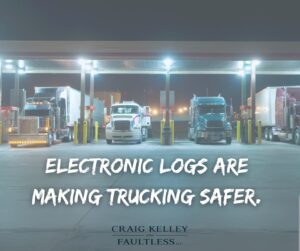
Drivers of commercial motor vehicles have complicated relationships with Electronic Logging Devices, a technology required by the government since 2019. The devices are controversial; some truck drivers appreciate them, while many don’t.
Electronic logs make the job more efficient but can feel like surveillance. They protect truckers but sometimes inconvenience them.
Before e-logs, truckers recorded their hours of service with paper logs. Electronic versions have become the standard because they are more accurate and harder to forge. I have compiled research and truckers’ opinions to help answer your questions about ELDs.
Here is everything you ought to know about the devices, including why, in the long run, they are making trucking safer for everyone on the roads.
First, some definitions: ELD, HOS, RODS, FMCSA
Trucking websites and federal transportation organizations use jargon that might be unfamiliar to the general public. Here are some terms you’ll see throughout this article.
ELD: Electronic logging device. Used to record truckers’ drives in real-time by pulling from the vehicle’s engine. Helps ensure drivers are operating safely.
HOS: Hours of service. These are regulated by the U.S. Department of Transportation and monitored by ELDs. Violating them can have serious ramifications.
RODS: Records of duty status. This is the log produced by ELDs. It shows a driver’s hours of service, total miles driven, the date and time, etc.
FMCSA: Federal Motor Carrier Safety Administration. The government agency that oversees commercial motor vehicles. Adopts and enforces policies to reduce crashes and fatalities on the roads.
How do electronic logging devices work?
There are dozens of ELDs available, and the best fit depends on a trucking company’s needs. The FMCSA provides a list of approved devices. If a truck driver is pulled for inspection and their device is not FMCSA-approved, they will be found in violation of the mandate. Considerations for companies choosing devices might include how large their fleet is or how available cellular networks will be to their drivers.
ELDs work by syncing with a vehicle’s engine to collect data. The device doesn’t start recording until the vehicle is moving at more than five miles per hour. It then produces records of duty status (RODS).
Information collected on the e-logs includes:
- Date
- Location
- Time
- Engine hours
- Vehicle miles
Drivers have four duty status options: driving, on-duty not driving, off-duty, or using sleeper berth. It is important to note that e-logs do not change HOS requirements.
Paper logs versus electronic logbooks
Before ELDs became the standard, paper logs were used for nearly 80 years. Truck drivers recorded their trips with pencil and paper. It was an honor system of sorts, wherein truckers were responsible for accurately self-reporting their drives and following HOS requirements. It could be challenging to prove that the logs were false.
The problem was, although cheating hours-of-service rules helped some truckers gain an advantage, it made the industry more dangerous. Drivers who push themselves too far are not fit to operate a flatbed truck, tractor trailer, or even a passenger car.
Today, paper logs are used as a backup if ELDs fail. In most other cases, though, electronic logs are required.
Are ELDs required for truck drivers?
The government introduced the ELD mandate for heavy-truck drivers in 2015 and began enforcing it two years later. From December 2017 to April 2018, companies and drivers had time to integrate ELDs into their operations. By December 2019, electronic logbooks were the standard used to ensure drivers followed HOS regulations.
The 2012 Moving Ahead for Progress in the 21st Century Act (known as MAP-21) called for the adoption of ELDs in the trucking industry. From then until now, the focus has been on keeping truckers and other drivers safe. How?
When large-truck drivers cheat HOS rules by driving for longer than they’re supposed to, taking insufficient breaks, and lacking sleep, they endanger the lives of everyone on the road. Before e-logs, truckers recorded their drives on paper. This made it easy for some drivers to lie, saying they took a break when they didn’t and driving for extensive periods.
I once took the deposition of a trucker who admitted to filling out his paper logs ahead of time. They were filled out for the entire month. Of course, they complied with the hours-of-service rules. They were also completely inaccurate. The trucker regularly violated HOS rules.
I have written before about the deadly cost of drowsy driving. Hours of service regulations are put in place so that truck drivers are well-rested. If a driver chooses not to follow them, they become a hazard.
Sometimes, though, the truckers weren’t the ones pushing for rule breaking. Trucking companies and fleet managers are guilty of pressuring their drivers into working past their limits. The ELD mandate protects truck drivers from exploitation by their employers.
Who is exempt from the electronic log requirement?
Certain commercial motor vehicle drivers are exempt from recording their hours with ELDs. They can use paper logs. These include:
- Drivers using short-haul exceptions
- Drivers who keep RODS for fewer than eight days in a 30-day period
- Drivers operating driveaway-towaway vehicles
- Drivers whose vehicles were manufactured before 2000
Pros and cons of ELDs: Real-world testimonies
Using Reddit conversation threads, I’ve gathered some first-hand opinions from truckers across the United States. Some drivers defend ELDs, while others criticize them. Here are some comments left about e-logs in the “Truckers” Reddit thread.
From one user:
- “It sets a clear boundary with your dispatch that you can’t be bullied into ignoring.
- It is an industry litmus test. If you constantly find yourself going over your hours, you either need to improve your trip plans or find another company.
- It is the starting building block towards finding a healthy balance between work and rest. There’s a reason our industry has traditionally had an early mortality rate. Your car and truck need maintenance, and so do you.”
Another user critiqued the hard-and-fast limits of e-logs:
“If you’re two minutes from a stop and you run out of time, you’re in violation. There’s no wiggle room.”
Some expressed that the logs make it more difficult to cheat HOS rules:
“To me, an ELD is a quick way to get into trouble.”
“The outlaw/super trucker hates the ELD. If you enjoy running legal, it’s not so bad.”
Other comments included concerns over strict observance of speed limits. While ELDs don’t directly report a truck’s speed, it can be calculated from how long it took the vehicle to travel a certain number of miles.
A common pro-ELD observation was that drivers no longer must remember to fill out paper logs. It saves them time and eliminates human error.
How is the ELD mandate enforced?
Roadside inspections and safety audits ensure that truck drivers are using ELDs and following HOS rules. To pass these inspections, the FMCSA instructs drivers to keep these items in their vehicles: ELD user manual, backup paper logs, and instruction sheets on transferring HOS records to officials and reporting malfunctions.
The motor carriers themselves must have e-logs/RODS data for the past six months, as well as documents pertaining to employees’ drives, expenses and payroll.
If a driver fails an inspection, they can be fined and temporarily sent out of service. The violation will also negatively affect the driver’s Compliance, Safety, Accountability (CSA) score.
Hours-of-service laws for truck drivers
Drivers of semis, tractor-trailers and other heavy trucks have been held to HOS standards since 1938. As years pass and new concerns arise, the FMCSA adjusts the rules. Commercial motor vehicles are defined primarily as those weighing 10,001 pounds or more.
Regulations for HOS are designed to keep drivers well-rested. They address maximum lengths for consecutive drive-times, rest times, hours spent in sleeper berths, and more. Here are some of the main takeaways:
- After a property-carrying driver has driven for eight hours, they must take a 30-minute break.
- Truckers can drive for 11 hours maximum after 10 consecutive hours off-duty.
- The 10-hour off-duty period can be split up, as long as it includes a minimum of seven hours in the sleeper berth.
HOS distinguishes between property-carrying vehicles (semi-trucks, tractor-trailers, flatbed trucks) and passenger-carrying vehicles, like buses or vans. The regulations for these vehicles differ slightly:
- Drivers can drive for 10 hours maximum after 8 consecutive hours off-duty.
- The eight hours drivers must spend in the sleeper berth can be split up, as long as each half is at least two hours.
As mentioned earlier in the article, the four options for drivers are driving, on-duty, off-duty, and sleeper berth.
The “driving” option is used for all the time an operator spends behind the wheel, driving.
On-duty is a broader option, used for any time a driver is waiting to be dispatched, preparing a load, driving, repairing, under inspection, etc. If an activity has anything to do with the person’s role as a motor carrier employee, it is classified as “on-duty” time.
Resting or sleeping counts as “sleeper berth” time. This can occur in the driver’s vehicle, in a compartment behind the cabin.
Lastly is the “off-duty” option. A driver is spending time off-duty when he is not driving, working, sleeping, etc.
The FMCSA website has a new tool that allows drivers to enter their e-log data and compare it against HOS rules to ensure they are not violating them.
It’s true that some drivers have more endurance than others. Age, physical health, experience and other factors can influence how many hours a person can drive before they get drowsy or distracted. Despite this, HOS regulations cannot be tailored to each of the millions of commercial motor vehicle drivers in the United States.
These rules set a standard to ensure the most safety possible and eliminate drowsy and impaired driving across the board. Without them, irresponsible companies and drivers would take risks and cause more wrecks.
Making trucking a safer industry
When it first made ELDs mandatory, the Department of Transportation expected that the rule would prevent 1,844 crashes, 562 injuries, and 26 deaths each year. Using ELDs meant truckers faced consequences if they drove tired, and fleet managers could no longer harass their drivers into pushing themselves too far.
The FMCSA’s 2023 Report to Congress showed that e-logs have been effective by enforcing HOS rules. According to the report, 1.19% of driver inspections in December 2017 revealed HOS violations. By December 2021, two years after the ELD requirement was fully implemented, that number dropped to 0.77%.
E-logs are more difficult to falsify, easier to keep track of, and more efficient for roadside inspections. Requiring them has helped make trucking a safer industry.
Despite this, there’s still a long way to go. Have you been seriously injured in an accident caused by a commercial motor vehicle? Personal injury and wrongful death attorneys who are educated in large-truck law can help you. The lawyers at Craig, Kelley and Faultless serve clients in Indiana, Illinois, Iowa, Kentucky, Ohio and Missouri. We have offices across Indiana and in St. Louis.
Contact us today at 1-800-746-0226 or by our online form.
David W. Craig sits on the Board of Regents of the Academy of Truck Accident Attorneys (which requires the board certification in truck accident law). He is the managing partner and one of the founding partners of Craig, Kelley & Faultless LLC. He is recognized as a Top 10 Trucking Trial Lawyer and Top 100 Trial Lawyer in Indiana by the National Trial Lawyers, as well as a Top 50 Indiana lawyer by Super Lawyers. David is the author of Semitruck Wreck, A Guide for Victims and Their Families, written to help people navigate a terrible situation by answering questions that come after a tragic wreck. He also hosts the podcast After the Crash, where you can gain valuable information about the dangers involving semis and large trucks that do not follow Indiana law safety protocol regarding speed, weather conditions, maintenance upkeep, etc.



 Email
Email Facebook
Facebook Twitter
Twitter